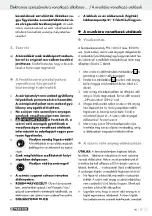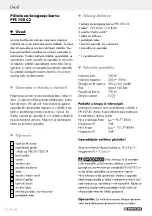
9
GB
General safety advice for electrical power tools / Advice on use
General safety advice for electrical power tools
Q
Additional safety advice
for paint spray guns
The spray gun must never be used for
spraying inflammable substances.
Spray guns must never be cleaned
using inflammable solvents.
If you do not know the level of danger
a substance presents, do not spray it.
Precise observation of
the hazard warnings, information and
data sheets available from the sprayed
medium manufacturer is essential.
Wear a breathing / dust
mask!
The inhalation of paint mist
and solvent vapour is hazardous to
health.
Work in adequately ventilated spaces
only.
Wear protective glasses!
Never aim the spray at living creatures.
DANGER OF EXPLOSION!
Do not use the
device in environments containing gases, open
flames, fires or gas-operated water heaters.
NO SMOKING!
Paint and solvents (thinners) must
have a flashpoint above 21°C.
Q
Advice on use
Viscosity
The Parkside paint spray gun PFS 100 C3 can be
used to apply sprayed media with a viscosity up to
80 DIN-sec. Viscosity is determined in a simplified
measuring procedure using the supplied measuring
cup (see Fig. C).
1. Immerse and fill the supplied measuring cup
13
to the top with the medium to be sprayed.
2. Lift the measuring cup
13
out of the medium
to be sprayed and let the liquid flow out (see
Figure C).
3. Measure the time in seconds it takes for the
flow of liquid out of the measuring cup to cease.
This time is the “DIN-seconds (DIN-s)” value of
viscosity.
4. If the value is too high, incrementally add and
mix in small quantities of a thinner compatible
with the medium to be sprayed. Proceed in ac-
cordance with the section about “Preparing the
sprayed medium”.
5. Remeasure the DIN-seconds value.
Repeat this procedure until a value is obtained
that complies with the values in the table.
Q
Preparing the sprayed medium
NOTE:
Most paints, varnishes etc. in the shops
are intended to be applied by brush not spray. To
achieve the best spraying result, you should prepare
your paint or varnish etc. in accordance with DIN
guidelines to achieve a suitable viscosity (see table).
Use a suitable thinner to achieve the required
thinning of the medium.
Never exceed the maximum viscosity for the
device. The sprayed medium must not be too
thick for the spraying process, otherwise it
could clog up the device.
Ensure that the sprayed medium and the thinner
are compatible with one another. If the wrong
thinner is used, it can lead to lumps forming
which may clog up the device. Never mix nitro-
thinners with synthetic resin paint.
Consult the sprayed medium manufacturer’s
documentation for information about suitable
thinners (water, solvents).
1. Thoroughly mix the unthinned sprayed medium
and bring it to average room temperature
(20–22 °C).
Do not increase the temperature to change the
viscosity.
2. Add a suitable thinner.
3. Test the viscosity as described above (see Fig. C).
NOTE:
Never use nitro-thinners to thin synthetic
resin paint!
Summary of Contents for 273487
Page 3: ...A B 13 14 12 8 9 1 2 9 10 5 4 3 6 7 8 11 1 2 3...
Page 4: ...F C E x x D 11...
Page 22: ...22...
Page 32: ...32...










































